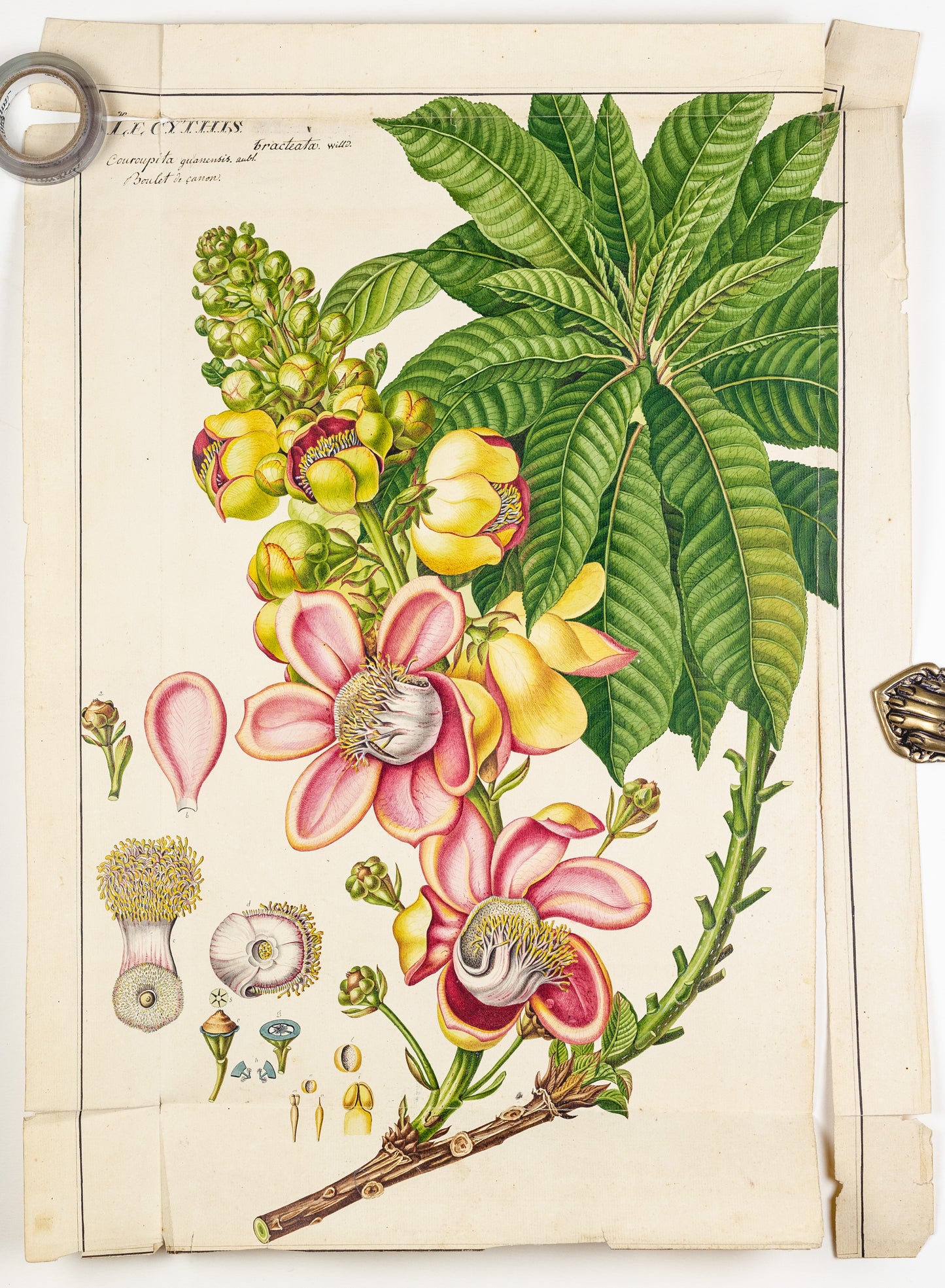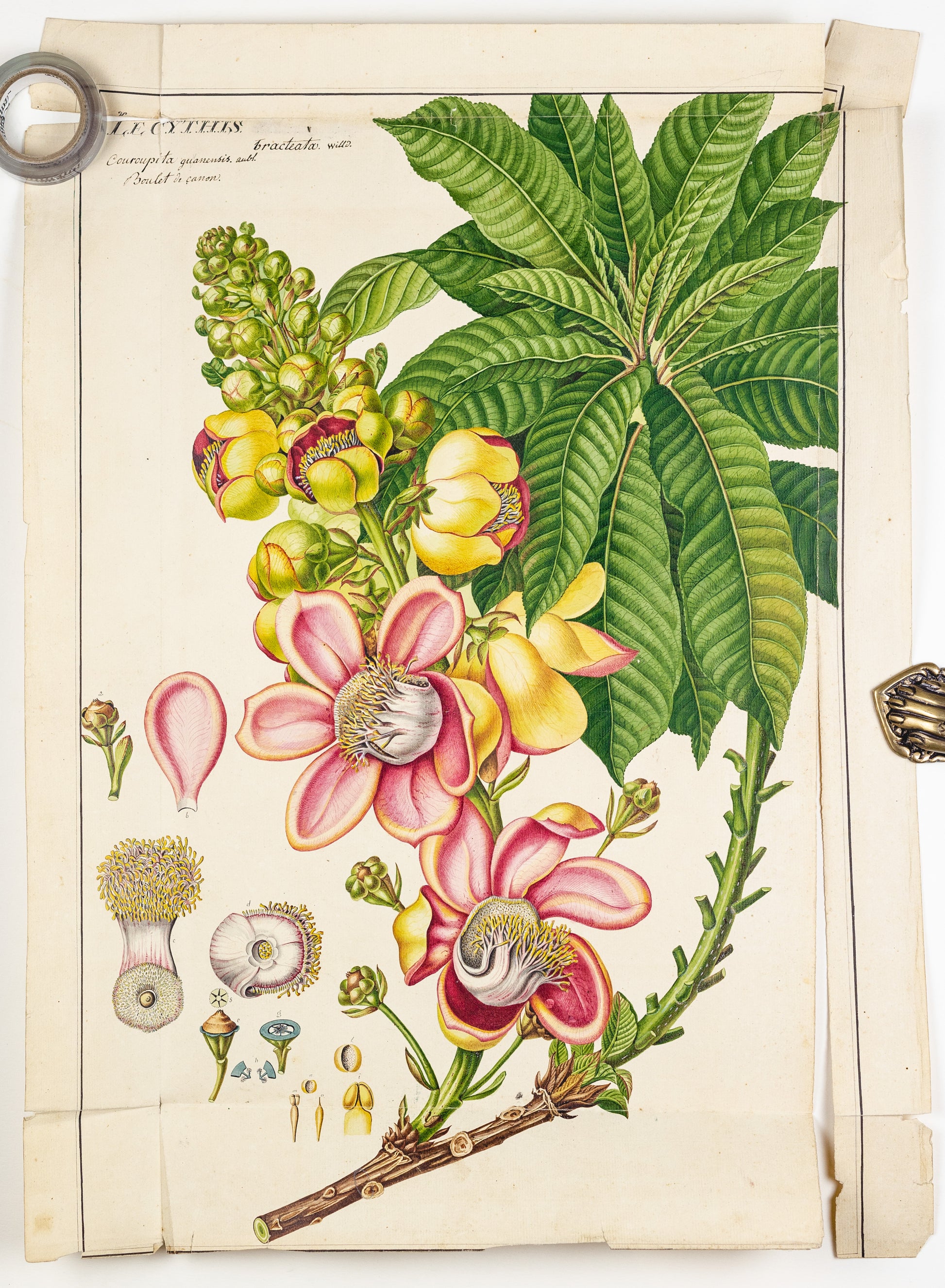from: Poiteau & Turpin Superb Botanical Drawings including varieties from the West Indies
PIERRE JEAN FRANÇOIS TURPIN (FRENCH, 1775 – 1840). Cannonball tree. 1808–1827.
PIERRE JEAN FRANÇOIS TURPIN (FRENCH, 1775 – 1840). Cannonball tree. 1808–1827.
Couldn't load pickup availability
PIERRE JEAN FRANÇOIS TURPIN (FRENCH, 1775 – 1840)
“Lecythis bractea willd Couroupita guianensus aubl. Boulet a canon (Couroupita guianensis, or Cannonball tree)”
Preparatory drawing for F.R. Tussac. Flore des Antilles, ou histoire générale botanique, rurale et economique des végétaux indigènes des Antilles.
Paris: chez l’auteur, F. Schoell et Hautel, 1808–1827. Vol 2 Pl. 10
Watercolor and pencil on paper
Inscribed: “Lecythis bractea willd Couroupita guianensus aubl. Boulet a canon”
Frame size: 31 x 24 1/4 in.
The cannonball tree, also known as Couroupita guianensis, was named by the French botanist Jean Baptiste Christophore Fusée Aublet in 1775. This species is native to the tropical forests of Central and South America and is cultivated in many other tropical areas throughout the world due to its fragrant flowers and large fruits. The Latin epithet guianensis means “of the Guianas,” an area of northeastern South America.
(continued)
Couroupita guianensis has potential medicinal uses for many of its parts and is culturally and religiously significant in South and Southeast Asia. In Sri Lanka and India, it has been widely misidentified as the Sal tree (Shorea robusta) after its introduction to the island by the British in 1881 and has been included as a common item in Buddhist temples.
Although the fruit is edible, it is not usually eaten by people because it can have an unpleasant smell in contrast to its intensely fragrant flowers. Instead, it is typically fed to livestock such as pigs and domestic fowl. The fruit and flowers contain the chemical compounds indigotin and indirubin, the same blue dye compounds found in the indigo plant (Indigofera tinctoria). Studies are being conducted on its possible use as a natural dye for fibers.
Some parts of the plant have medicinal use to treat hypertension, inflammation, the common cold, and some skin conditions.
Tussac described this plant as follows:
“This tree, one of the most beautiful that North and South America can be proud of… the flowers stand out for their large size, their singular shape, and their beautiful dark pink color… This tree, which is usually found only in the large forests of America, is distinguished by its tall stature, by its bushy crown, whose multiplied and variously arranged branches are adorned with large and beautiful leaves, of a cheerful green, at the through which are proudly displayed, long clusters of flowers of great dimensions, which charm the eyes with the brilliance of their colors, and flatter the sense of smell with the delicious aroma that they spread in the atmosphere: the traveler least sensitive to the beauties of nature, stops spontaneously, and cannot refuse his homage to this superb inhabitant of the ancient forests, where he seems to have been deliberately relegated; closer to inhabited countries, it could become disastrous by the fall of its large fruits to those whom it would have attracted by the freshness of its foliage and the beauty of its flowers; despite this inconvenience, one of these trees was planted in Santo Domingo, by a member of the Philadelphian circle, in a small garden near Cap Francais (Haitian Cape), where it received homage from enthusiasts; I myself made frequent visits to it with Mr. Turpin, as learned botanist as he was an excellent natural history painter; the beautiful drawing that I present here to the public is his, as are the anatomical details of the flowers and the fruit. Aubleta finds the plant in the great forests of Guiana, the natives of the country call it couroupitoutoumou, the French call it cannonball; some Creoles give it the name wild apricot, due to the resemblance of its fruit to that of the mamme (sp?), which incorrectly bears the name apricot in the West Indies. Mr. Delahaye, parish priest of Dondon, who dealt with botany, assured me that he found the couroupite in the mountains of Saint-Domingue. The soldiers garrisoned at Cap Francais (Haitian Cape) were particularly fond of this tree; in the flower buds they saw musket balls; in the fruit, a cannonball, or a bomb… The fruit has an acidic flavor and is not used as food.”


